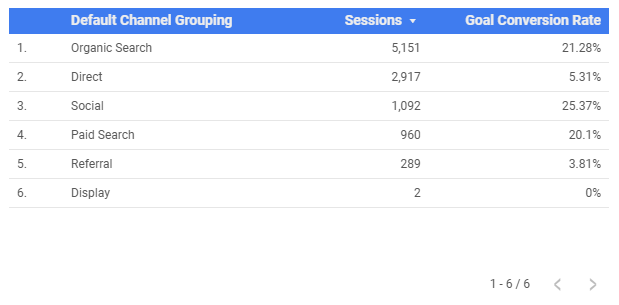Reporting is often the least favourite part of a marketer’s job. It takes forever. You aren’t sure what will show progress. What if something didn’t go well? No one will read it anyway. The list goes on.
What if you focus your reporting down to only the essentials? What if you only report on the things that truly matter to your client or boss? This isn’t a pipe dream—it just requires more work up front.
Reports that don’t work typically fall into one of these three categories:
- It isn’t a report, it’s just data;
- The report contains absolutely everything (just in case!); or
- The metrics included in the report don’t tell anyone anything they need to know.
Not a report, just data.
Reports should be more than a recitation of numbers. Anyone can open Google Analytics and look at the data—what we are paid for is our expertise in uncovering insights from those numbers. The data might show you that organic traffic is decreasing, but what you really need to know is WHY organic traffic is decreasing.
Everything! Just in case.
This is a tricky one to get past because some people equate volume with value. If you were paid $20,000 for a report, would you be comfortable presenting a single page report? That’s a lot of money for that one page.
What if you present a 47 page report? You’re suggesting that every page is as important as the next and that often has the opposite effect than you intend. It makes it seem like no page is all that important.
That being said, don’t assume that a shorter report is always better. A one page report can suck just as badly as a 47 page one. It’ll just take less time for your client to realize it sucks.
Things that don’t matter.
Ask a digital marketer to start building a report and they’ll probably include a table of sessions and conversions by channel.

But what does this tell us? It’s just data. It doesn’t tell us if we’re going where we need to go. We have no idea if we are going to get to our destination on time. Are the conversions even good conversions or are they vanity metrics? If a reporting element doesn’t tie back to the goal, it shouldn’t be in the report.
Start with the end
Start projects by thinking about where we want to be at the end of the project. We call this exercise the Goal Charter.
What is a Goal Charter?
A goal charter outlines every goal that we’ve been given by our clients and breaks it down into clear objectives and measurable results. It’s a document, not a spreadsheet. This is a narrative exercise that clearly walks from goal to strategy to tactic to KPI to metric.
The goal charter answers three key questions:
- What are your goals?
- Why do these goals exist?
- How will we know when we’ve met these goals?
What are your goals?
Goal-setting can be frightening because when you write down a goal, you commit to achieving it. Marketers often suffer from an intense fear of failure and this leads to soft goals or subbing in tactics for goals. Writing down a goal to “post one new blog post per month” is an example of a tactic disguised as a goal.
Every goal should be SMART: Specific, Measurable, Attainable, Realistic and Time-Based. To learn more about setting SMART goals, watch Dana’s presentation, Prove Your Value, at MozCon 2014.
In addition to setting SMART goals, take some time to think about lofty hopes and dreams. Aspirational goals can be unifying for teams. Talking about dreams can uncover new ways to measure progress that we hadn’t considered before. For example, a wellness company once told us that they wanted to change the way people thought about the word healthy.
Goal: Change how people perceive “healthy”.
- Phrased as a question: Are we changing the way people perceive the concept of “healthy”?
- Tactic: Research and write content about the evolving definition of health.
- Tactic timeline: 1-2 social posts per week, 1 blog post specifically on this topic per quarter.
- Goal progress measurement: number of people commenting on social posts and blog posts acknowledging a shift in their thinking, number of people leaving positive reviews with specific language about changed perceptions.
It’s helpful to find ways to measure goal progress if we phrase goals as questions. Using questions makes it easy for clients to connect data visualizations to goals and then to plan tactics that impact goal success.
For example:
- How many times did our phone ring?
There were 403 phone calls, up 325% from previous period.
Wow that postcard we delivered worked! More print! - How many visits did we get from local search results?
1,453 visits, down 47% from previous period.
Whoa we aren’t in the top three map pack for that important keyword anymore. Gotta fix that.
Why do these goals exist?
This can be an easy question (“these goals exist because we need to make payroll!”) or very difficult (“we have no idea where this goal came from but it’s in our strategic plan that the board approved so we have to make it happen”). Getting the context behind a goal helps determine how important a goal is, particularly when you’re faced with an abundance of goals but a lack of resources. Context is key for prioritization!
How will we know when we’ve met these goals?
This is what turns a goal from a ball of fluff into something SMART. Doing this also helps you figure out what data points you’re going to need, what systems you’ll need access to, and how these systems need to talk to each other. You want to go through this part early in the process, not towards the end. There’s nothing worse than realizing that you would’ve known if the campaign was a success if only you’d set up a certain process back in the beginning.
Start planning your report
At the end of every goal charter, we list out what a report will contain. Since this is covered right up front, clients can review the concept before any work has been done. This planning process provides the time needed to talk to the different people involved in getting various systems talking to each other. This is also when the changes needed in Google Analytics and Google Tag Manager should be implemented. Perhaps the biggest benefit of planning is that when it’s time for that first report review, there aren’t any surprises—that report is the culmination of the goal charter process.
A note about Monitoring vs Reporting
We need to talk about the difference between monitoring and reporting. Often what we think are reports are just fancy looking dashboards. Monitoring is the data, reporting is the insight. Monitoring is still very important — but it isn’t a report.
Here’s an example. On the 4th of the month, a web developer accidentally removes the Google Tag Manager code from a website. Unfortunately, you only check on traffic at the end of every month when you pull your report, so now you’re missing 26 days of data. Monitoring would have eliminated this problem.
The last thing you want to say to a client or boss is “we see that organic traffic dropped mid-way through the month and we are going to figure out how what happened and then fix it”. What you should be saying is “we saw that organic traffic started dropping mid-way through the month and realized it was because some spammy local listings entered your niche. We reported them and the problem cleared up a week later”. That’s what monitoring does for you! It gives you the opportunity to react right away, instead of having to react with a red face in a crummy report meeting.
Monitoring isn’t the same as reporting because when we monitor we see things as they happen and can react. Proper monitoring means that you don’t have any surprises when it comes time to pull an actual report. Instead of trying to figure out what went wrong, you can spend your time on insights about what went right and then plan to do more of that.
Share the goal charter
Now that you have this valuable document outlining all the great work you’re going to do together, don’t hide it away. Share it with everyone at your organization! Everyone has an opinion on marketing. If you aren’t able to set a course and point everyone in the same direction, people will chime in with their opinions. You’ll end up getting pulled in a million different directions, but you’ll go nowhere useful.
People don’t switch agencies or hire new in-house marketers because they want more of the same.
People make changes when they don’t understand how what you’re doing is meant to help them get to where they want to go. What’s worse is that their organization might not even have a unified understanding of where they want to go! Without this knowledge, the guideposts of accountability and trust are muddied. It’s easy to point fingers and play the blame game, but what’s really to blame is that no one agreed what to report on when the relationship was first starting.
Tie goals back to real results and communicate the why and how to your entire organization and everyone will be on board. People need to know where you’re rowing the boat to (and why!). We all want to be better and to do better marketing—so we need to articulate what better means, and agree about how we’re going to get there.




